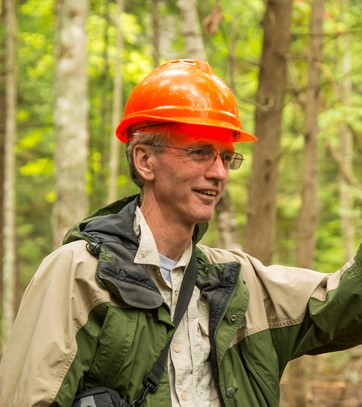William Livingston
Research Interests
Use of dendrochronolog to investigate factors involved in tree diebacks and declines. These factors include invasive pests, climate, and site characteristics.
Research Projects
Sustaining Wabanaki Traditions through Adaptation: Preparing for the Emerald Ash Borer in Maine
Media Expertise:
Tree Pests
Tree Disease
Degrees
- University of Minnesota, Ph.D. (Plant Pathology)
- University of Idaho, M.S. (Forest Science)
- Michigan Technological University, B.S. (Forestry)
Courses
- SFR 100: Introduction to Forest Biology
- SFR 457/557: Tree Pests & Disease
- SFR 101: Introduction to Forest Resources
- SFR 111/112: Forests Through Time
Profile
William Livingston is an Associate Professor of Forest Resources, as well as the Associate Director of Undergraduate Programs for the School of Forest Resources. His research, teaching, and outreach activities revolve around the health of forests both in Maine and across the country. His research involves assessing relationships between climate and tree pests, relating stand history and development to pest problems and tree health in island spruce stands, and investigating the cause of white pine decline. Livingston’s research and teaching activities are based on the concept that Maine’s forests provide an ideal living classroom in which to investigate how land use history affects the health of today’s forests and to evaluate the impacts of invasive species.
The goal of Livingston’s SSI project (Mobilizing to Fight an Invasive Insect) is to study and facilitate the ways that Wabanaki basketmakers, tribes, state and federal foresters, various university researchers, landowners and others come together to prevent, detect, and respond to the emerald ash borer (EAB). The EAB is a potentially devastating invasive threat to all three species of ash trees found in Maine, and since 2002 has moved from Michigan east to New York.
Selected Publications
Matthew T. Kasson and W. H. Livingston, “Relationships Among Beech Bark Disease, Climate, Radial Growth Response and Mortality of American Beech in Northern Maine, USA,” Forest Pathology 42 (2012): 199-212.
D. Ranco, A. Arnett, E. Latty, A. Remsburg, K. Dunckel, E. Quigley, R. Lilieholm, J. Daigle, B. Livingston, J. Neptune, and T. Secord, “Two Maine Forest Pests: A Comparison of Approaches to Understanding Threats to Hemlock and Ash Trees in Maine,” Maine Policy Review 21, no. 1 (2012): 76-89.
Matthew T. Kasson and William H. Livingston, “Spatial Distribution of Neonectria Species Associated with Beech Bark Disease in Northern Maine,” Mycologia 101 (2009): 190-195.
E.L. Rowland, A.S. White, and W.H. Livingston, “A Literature Review of the Effects of Intensive Forestry on Forest Structure and Plant Community Composition at the Stand and Landscape Levels,” Maine Agricultural and Forest Experiment Station Miscellaneous Publication 754 (2005): 28 pages.
M.E. Day, J.L. Schedlbauer, W.H. Livingston, M.S. Greenwood, A.S. White, and J.C. Brissette, “Influence of Seedbed, Light Environment, and Elevated Night Temperature on Growth and Carbon Allocation in Pitch Pine (Pinus rigida) and Jack Pine (Pinus banksiana) Seedlings,” Forest Ecology and Management 205 (2005): 59-71.
K.A. Sokol, M.S. Greenwood, and W.H. Livingston, “Impacts of Long-Term Diameter-Limit Harvesting on Residual Stands of Red Spruce in Maine,” Northern Journal of Applied Forestry 21 (2004): 69-73.
M.S. Greenwood, W. H. Livingston, M. E. Day, S. C. Kenaley, A. S. White, and J. C. Brissette, “Contrasting Modes of Survival by Jack and Pitch Pine at a Common Range Limit,” Canadian Journal of Forest Research 32 (2002): 1662-1674.
D.K. Manter and W.H. Livingston. “Interaction of Microorganisms, Insects, and Freezing Injury on Conifers,” in Conifer Cold Hardiness, eds. F. J. Bigras and S. J. Colombo (The Netherlands: Kluwer Academic Publishers, 2001), 289-304
Anne E. Lund and W.H. Livingston, “Freezing Cycles Result in Winter Injury on Picea rubens Sarg,” Tree Physiology 19 (1999): 65-69.
D. K. Manter and W.H. Livingston, “Thawing Rate and Fungal Infection by Rhizosphaera kalkhoffii. Bubak Influence Freezing Injury on Red Spruce (Picea rubens sarg.) Needles,” Canadian Journal of Forest Research 26 (1995): 918-927.

